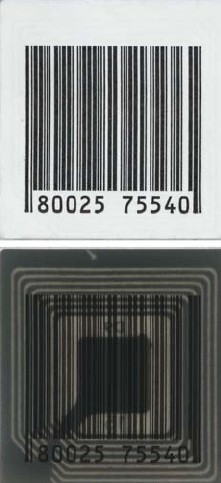- Relief printing
- Intaglio and planographic printing
- Color printing
- Bits and pieces
- Early photography in silver
- Non-silver processes
- Modern photography
- Color notes
- Color photography
- Photography in ink: relief and intaglio printing
- Photography in ink: planographic printing
- Digital processes
- Where do we go from here?
Pictures for machines

Laser print. DHL. DHL Express. Bar code. 2006. 6 3/4 x 4 1/2" (17.1 x 11.4 cm). The Museum of Modern Art, New York. Gift of Richard Benson.
Throughout the long history of printing, and indeed of all forms of picture-making, images were made for the use of human beings. Something radically new began to take place in commerce in the last part of the twentieth century, in the development of the humble bar code, used to control inventories, sales data, shipment-tracking information, and so on. This simple device was innovative because it became a widespread form of picture designed solely for the use of machines, not people. Machines had been looking at pictures in industry for some time; the registration system for the web press is a good example, in which an electric eye examines a register mark to fit high-speed printing. The bar code, however, moved out into society at large and reduced the activity of the hand even more—data no longer had to be typed into a cash register or written on a slip, because all this was taken care of automatically by the data transferred when a machine read the simple code on the package.

A bar code, shown at top as a reflective print and below illuminated as a transparency. This small inventory device, this one from a bookstore, contains in the dark central area a hidden picture, which, unless it is disabled during checkout, can be read electronically to alert the store that a product is being removed illegally.
The bar code is read by being scanned. It is interesting that the camera used to access this information is not the old single-lens one of photography but the new one of the scanner. All forms of scanners, from the expensive ones that use a rotating drum to the cheap little ones that fit on our desk, do their work by making a picture that is not for human consumption. When we scan a picture into our computer we never see the data taken in; instead we view an analog surrogate, put up on the computer screen for our convenience. The scan itself is a string of numbers, intelligible only to the computer. It isn’t just the hand that is disappearing here but the human being as well.

